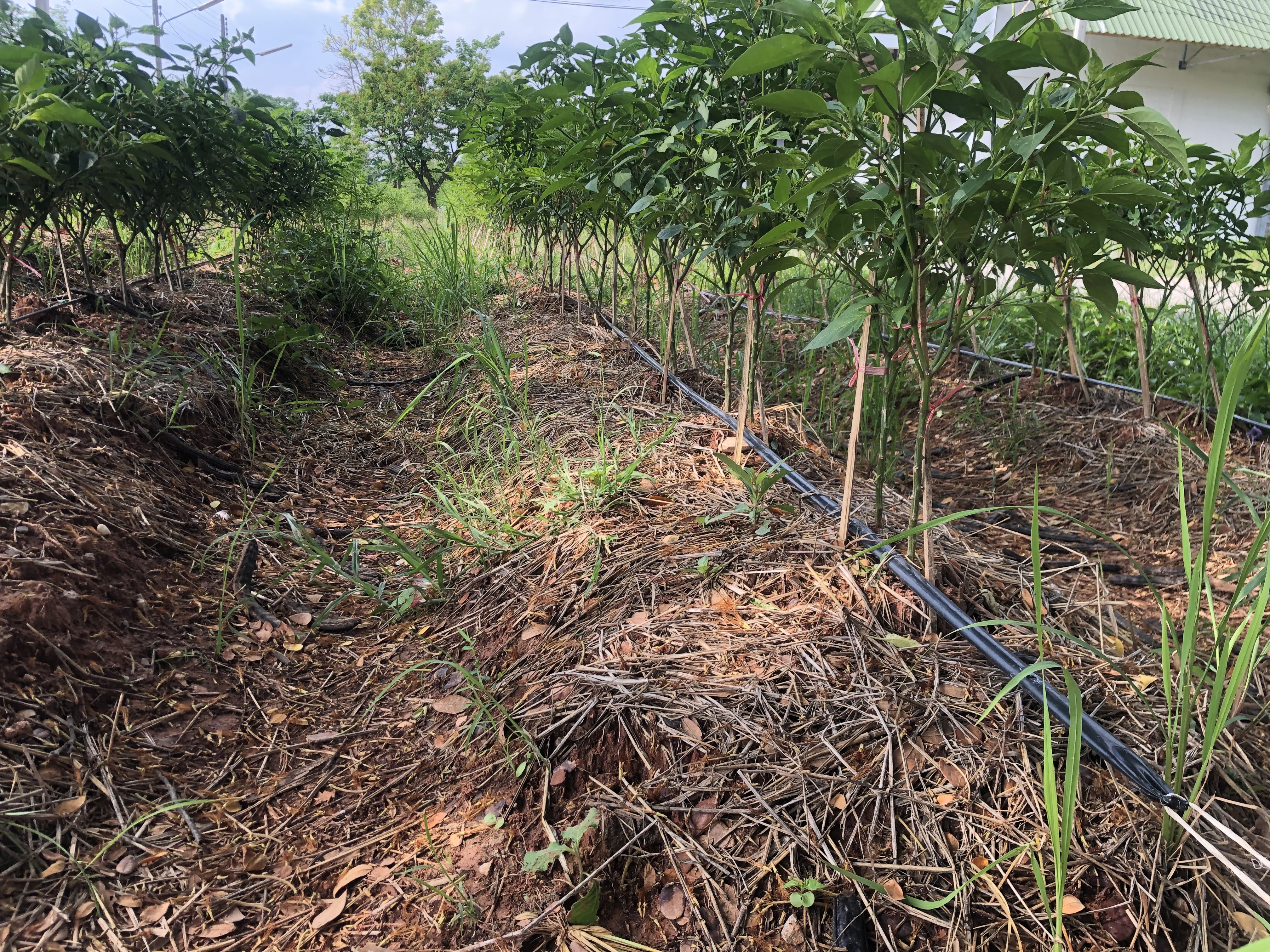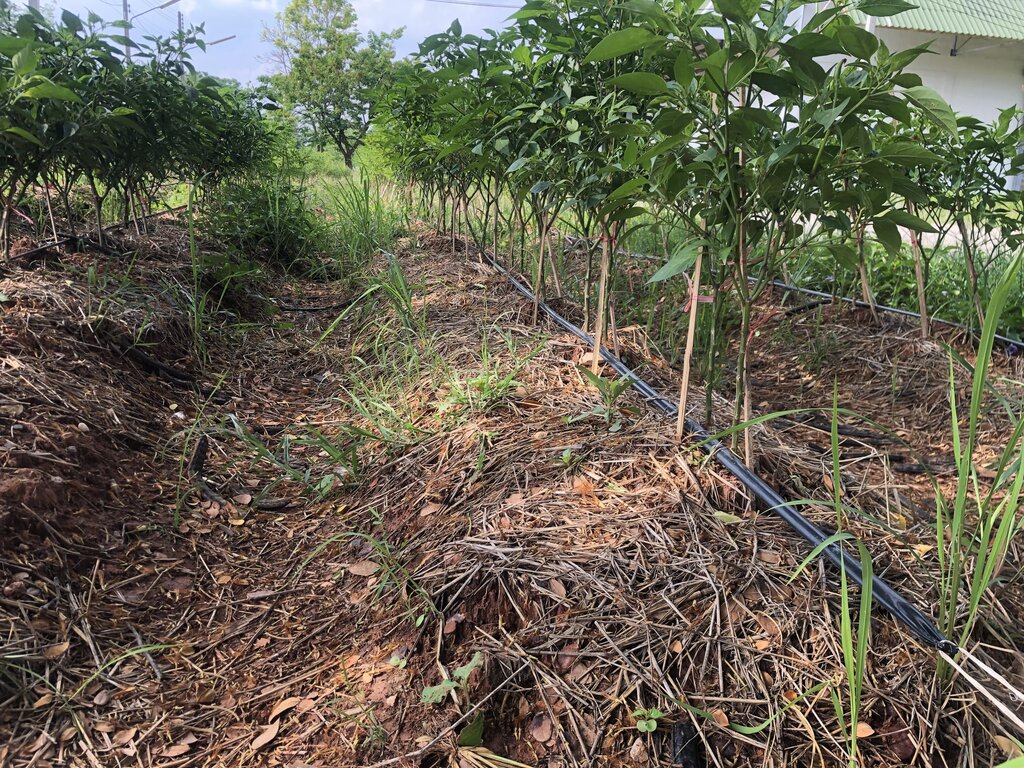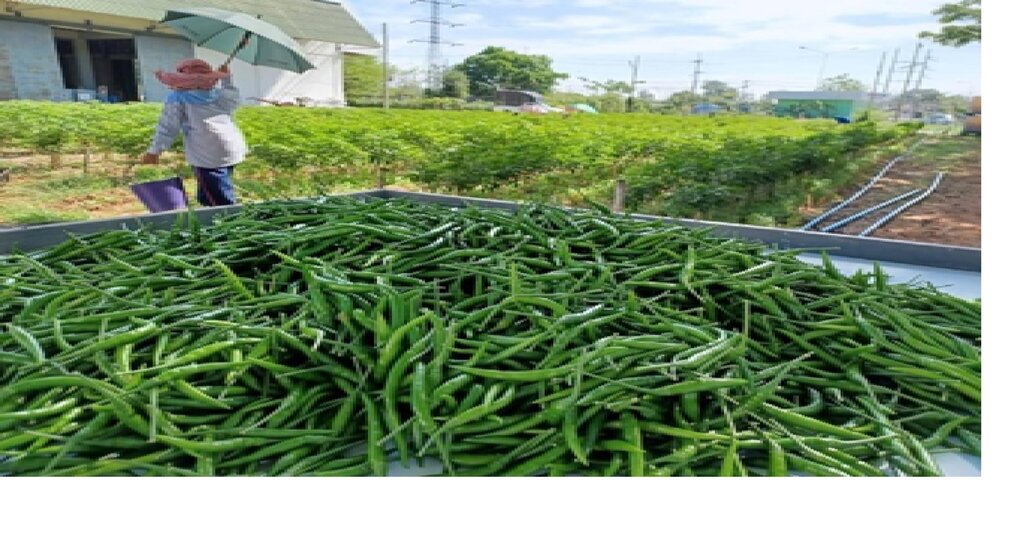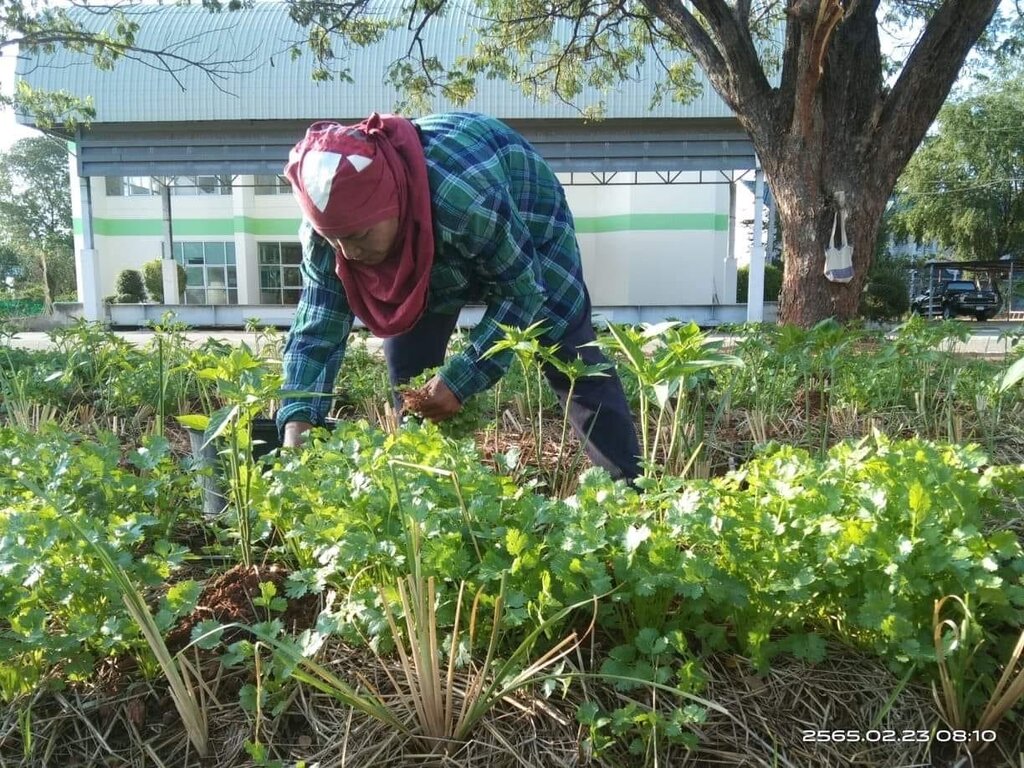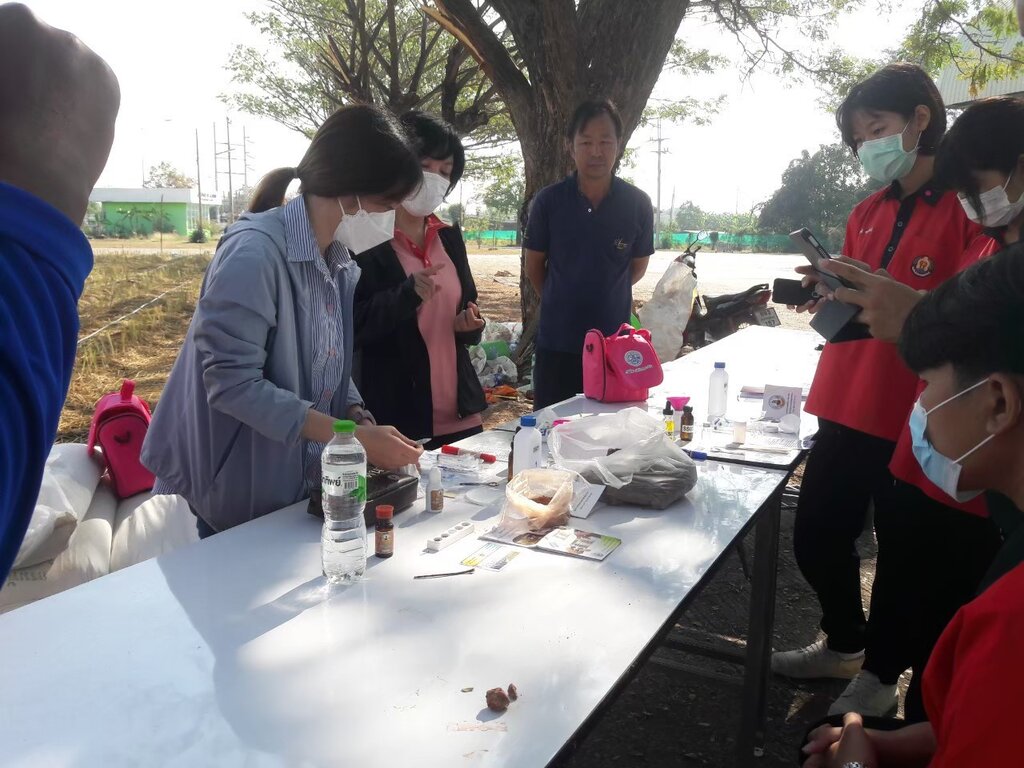INTEGRATED AGRICULTURE-BASED LAND USE IN AREAS WITH SALINE SOILS [Thailand]
- Creation:
- Update:
- Compiler: Laksamee Mettpranee
- Editor: –
- Reviewers: William Critchley, Rima Mekdaschi Studer
technologies_7276 - Thailand
View sections
Expand all Collapse all1. General information
1.2 Contact details of resource persons and institutions involved in the assessment and documentation of the Technology
Key resource person(s)
land user:
Siangsunthia Mana
Thailand
SLM specialist:
co-compiler:
Name of project which facilitated the documentation/ evaluation of the Technology (if relevant)
Decision Support for Mainstreaming and Scaling out Sustainable Land Management (GEF-FAO / DS-SLM)Name of the institution(s) which facilitated the documentation/ evaluation of the Technology (if relevant)
Land Development Department (Land Development Department) - Thailand1.3 Conditions regarding the use of data documented through WOCAT
The compiler and key resource person(s) accept the conditions regarding the use of data documented through WOCAT:
Yes
1.4 Declaration on sustainability of the described Technology
Is the Technology described here problematic with regard to land degradation, so that it cannot be declared a sustainable land management technology?
No
2. Description of the SLM Technology
2.1 Short description of the Technology
Definition of the Technology:
Salinity and associated land degradation in parts of the Northeast of Thailand limits production. Knowledge of saline soil management was integrated into an organic agriculture system: dolomite application adjusted pH levels, manure increased the soil's organic matter, while fermented bio-extracts stimulated root systems. Yields of chili pepper and parsley improved greatly.
2.2 Detailed description of the Technology
Description:
The problem of soil degradation in regions with saline soil such as parts of the Northeast of Thailand shows up as chemical and physical deterioration and low fertility, which are significant limitations to land use. These issues are exacerbated by water shortages in the dry season and excessive rainfall during the cropping season.
To address this, a group of farmers interested in learning effective soil management strategies has formed. Their aim is to mitigate the effects of salinity and improve crop productivity on their farms. The group has received support in the form of production inputs, including microbial activators for producing organic fertilizers and bio-fertilizers, vetiver grass of the Songkhla 3 variety, and dolomite. Additionally, they have implemented guidelines based on learning, observation, and trial and error to develop a 0.04-hectare vegetable plot.
Previously, this area was characterized by low soil fertility and salinity, which resulted in reduced crop yields. The sandy clay loam soil, though slightly saline, had very low moisture content during the dry season. Furthermore, the area lay outside the irrigation zone. To answer these questions, farmers in the community of Moo 5, Ban Kok Phrom, Non Thai Sub-district, collaborated to develop sustainable farming practices. With support from the Land Development Department, they integrated knowledge of saline soil management into an organic agriculture system.
This technology began with soil analysis and appropriate measures for managing saline soil before land preparation. Farmers combined their wisdom with Land Development Department technologies, such as dolomite application to adjust pH levels and eliminate pathogenic microorganisms affecting chili pepper growth. Manure was applied to increase the soil's organic matter, while fermented bio-extracts containing beneficial microbes stimulated root systems.
To conserve soil moisture, drip irrigation technology was installed in the chili planting plots, and the soil was covered with straw. Vetiver grass was also used to further conserve moisture as a grass barrier strip. After these soil amendments, the soil structure improved, becoming friable and suitable for planting chili peppers—specifically the Amphawa Gold variety, which has a high market demand.
Additionally, parsley was intercropped between plots to optimize land use. On average, the chili pepper yields reached 400 kilograms per 400 square meters over 180 days, with a market price of about 2.50 USD per kilogram. Parsley, as a by-product of watering the chili pepper plants, produced just over 100 kilograms per 400 square meters per production cycle of chili peppers.
2.3 Photos of the Technology
2.5 Country/ region/ locations where the Technology has been applied and which are covered by this assessment
Country:
Thailand
Region/ State/ Province:
Nakhonratchasima
Further specification of location:
Moo 5, Ban Kok Phrom, Non Thai sub-district, Non Thai district
Specify the spread of the Technology:
- evenly spread over an area
If precise area is not known, indicate approximate area covered:
- 100-1,000 km2
Is/are the technology site(s) located in a permanently protected area?
No
Map
×2.6 Date of implementation
Indicate year of implementation:
2022
2.7 Introduction of the Technology
Specify how the Technology was introduced:
- through projects/ external interventions
Comments (type of project, etc.):
Farmer groups in Non Thai Subdistrict and nearby areas transfer knowledge through the volunteer soil doctor network.
3. Classification of the SLM Technology
3.1 Main purpose(s) of the Technology
- improve production
- reduce, prevent, restore land degradation
- preserve/ improve biodiversity
- create beneficial economic impact
3.2 Current land use type(s) where the Technology is applied
Land use mixed within the same land unit:
No

Cropland
- Annual cropping
Annual cropping - Specify crops:
- vegetables - other
Number of growing seasons per year:
- 1
3.3 Has land use changed due to the implementation of the Technology?
Has land use changed due to the implementation of the Technology?
- No (Continue with question 3.4)
Land use mixed within the same land unit:
No
3.4 Water supply
Water supply for the land on which the Technology is applied:
- mixed rainfed-irrigated
Comments:
The area is outside the full irrigation zone and has a local or community small size water sources.
3.5 SLM group to which the Technology belongs
- integrated soil fertility management
- integrated pest and disease management (incl. organic agriculture)
3.6 SLM measures comprising the Technology

agronomic measures
- A1: Vegetation/ soil cover
- A2: Organic matter/ soil fertility
- A5: Seed management, improved varieties
3.7 Main types of land degradation addressed by the Technology

chemical soil deterioration
- Cs: salinization/ alkalinization

physical soil deterioration

biological degradation
3.8 Prevention, reduction, or restoration of land degradation
Specify the goal of the Technology with regard to land degradation:
- prevent land degradation
- reduce land degradation
4. Technical specifications, implementation activities, inputs, and costs
4.1 Technical drawing of the Technology
Technical specifications (related to technical drawing):
Cultivation plot preparation
1. Plough and harrow the soil, then plough again using a 65 HP tractor and a small Kubota tractor for further tilling.
2. Raise ridges to 30 cm high and 60 cm wide, with 1-meter spacing. Burn plant residues to kill bacteria and fungi, then water to extinguish the blaze.
3. Apply dolomite at 156.25 kg/hectare and bioslurry (100 kg/rai) after fermentation. Mix in bio-extract (2 spoons per 20L water) to improve soil and stimulate root growth.
4. Mix soil with 3 handfuls of soil and 1 handful of dung.
5. Dry the soil for 7-14 days, then place a 10 cm banana stem at the bottom of the planting hole before planting.
Planting and maintenance
1. Plant 35-day-old Amphawa Gold chili peppers, sprinkle parsley around the plot, cover with rice straw, and plant vetiver around the edges.
2. Water in the morning and use fermented Indian Laburnum pod extract (2 spoons per 20L water) in the evening. Spray wood vinegar weekly to prevent fungi.
3. When buds appear, spray LDD 2 every 5 days in the evening.
4. Set up a drip system for backup watering in case of labor shortage.
5. If anthracnose occurs, remove affected chili peppers. For aphids, spray plain milk on the affected areas, leave for 20 minutes, then wipe off.
6. Remove old leaves at 45-50 days to expose the trunk to sunlight, promoting better growth and higher yields
Harvesting yields
1. Harvest the first generation of chili peppers at 65 days, then harvest every 5 days for the next 6 months.
Author:
Ms. Nisa Sahoh
Date:
01/04/2025
4.2 General information regarding the calculation of inputs and costs
Specify how costs and inputs were calculated:
- per Technology area
Indicate size and area unit:
1.12ha
If using a local area unit, indicate conversion factor to one hectare (e.g. 1 ha = 2.47 acres): 1 ha =:
6.25rai
Specify currency used for cost calculations:
- USD
Indicate average wage cost of hired labour per day:
8.82 USD
4.3 Establishment activities
| Activity | Timing (season) | |
|---|---|---|
| 1. | Drip irrigation system installed | Before mulching/ cropping (March) |
| 2. | None | |
| 3. | None |
4.4 Costs and inputs needed for establishment
| Specify input | Unit | Quantity | Costs per Unit | Total costs per input | % of costs borne by land users | |
|---|---|---|---|---|---|---|
| Labour | Drip lines | metre | 4.6 | 1.76 | 8.1 | |
| Labour | PVC tubes | metre | 10.0 | 0.59 | 5.9 | |
| Labour | 1000 litre tank | piece | 1.0 | 67.65 | 67.65 | |
| Labour | None | None | ||||
| Total costs for establishment of the Technology | 81.65 | |||||
| Total costs for establishment of the Technology in USD | 81.65 | |||||
4.5 Maintenance/ recurrent activities
| Activity | Timing/ frequency | |
|---|---|---|
| 1. | Cultivation plot preparation | |
| 2. | Planting and maintenance | |
| 3. | Harvesting yields | |
| 4. | In case of an anthracnose epidemic, destroy the chili pepper stricken with the disease. During an outbreak of aphids, spray with plain milk at the point of the outbreak. Leave it for 20 minutes and then wipe it off. | |
| 5. | Remove leaves of the chili peppers when they are 45-50 days in order to make the trunk expose to the sun. This helps chili peppers grow well and increase their yields. |
4.6 Costs and inputs needed for maintenance/ recurrent activities (per year)
| Specify input | Unit | Quantity | Costs per Unit | Total costs per input | % of costs borne by land users | |
|---|---|---|---|---|---|---|
| Labour | Ploughing to prepare plot | Person days | 1.0 | 8.08 | 8.08 | |
| Labour | Soil preparation | Person days | 1.0 | 4.41 | 4.41 | |
| Labour | Cultivation, watering, plot maintenance | Person days | 1.0 | 24.25 | 24.25 | |
| Labour | Harvesting | Person days | 1.0 | 137.64 | 137.64 | |
| Equipment | Tractor/ cultivator maintenance | Fuel etc | 1.0 | 75.0 | 75.0 | |
| Plant material | Chili peper plant | plant | 1200.0 | 0.029 | 34.8 | |
| Plant material | Parsley seeds | gram | 600.0 | 0.01 | 6.0 | |
| Plant material | Rice straw | kilogram | 180.0 | 0.1 | 18.0 | |
| Fertilizers and biocides | Fermented bio-extracts | liter | 120.0 | 0.29 | 34.8 | |
| Fertilizers and biocides | Dolomite | kilogram | 13.6 | 0.73 | 9.93 | |
| Fertilizers and biocides | Dung | bag | 35.0 | 2.5 | 87.5 | |
| Other | Drip line | meter | 4.6 | 1.76 | 8.1 | |
| Other | PVC tube | meter | 10.0 | 0.59 | 5.9 | |
| Other | 1,000 liter bucket | bucket | 1.0 | 67.65 | 67.65 | |
| Total costs for maintenance of the Technology | 522.06 | |||||
| Total costs for maintenance of the Technology in USD | 522.06 | |||||
Comments:
Drip irrigation systems have no maintenance costs but they are replaced after 2 to 3 years.
4.7 Most important factors affecting the costs
Describe the most determinate factors affecting the costs:
1. Labour costs
5. Natural and human environment
5.1 Climate
Annual rainfall
- < 250 mm
- 251-500 mm
- 501-750 mm
- 751-1,000 mm
- 1,001-1,500 mm
- 1,501-2,000 mm
- 2,001-3,000 mm
- 3,001-4,000 mm
- > 4,000 mm
Agro-climatic zone
- sub-humid
5.2 Topography
Slopes on average:
- flat (0-2%)
- gentle (3-5%)
- moderate (6-10%)
- rolling (11-15%)
- hilly (16-30%)
- steep (31-60%)
- very steep (>60%)
Landforms:
- plateau/plains
- ridges
- mountain slopes
- hill slopes
- footslopes
- valley floors
Altitudinal zone:
- 0-100 m a.s.l.
- 101-500 m a.s.l.
- 501-1,000 m a.s.l.
- 1,001-1,500 m a.s.l.
- 1,501-2,000 m a.s.l.
- 2,001-2,500 m a.s.l.
- 2,501-3,000 m a.s.l.
- 3,001-4,000 m a.s.l.
- > 4,000 m a.s.l.
Indicate if the Technology is specifically applied in:
- not relevant
5.3 Soils
Soil depth on average:
- very shallow (0-20 cm)
- shallow (21-50 cm)
- moderately deep (51-80 cm)
- deep (81-120 cm)
- very deep (> 120 cm)
Soil texture (topsoil):
- coarse/ light (sandy)
Soil texture (> 20 cm below surface):
- medium (loamy, silty)
Topsoil organic matter:
- medium (1-3%)
- low (<1%)
5.4 Water availability and quality
Ground water table:
on surface
Availability of surface water:
good
Water quality (untreated):
for agricultural use only (irrigation)
Water quality refers to:
surface water
Is water salinity a problem?
Yes
Is flooding of the area occurring?
No
5.5 Biodiversity
Species diversity:
- medium
Habitat diversity:
- medium
5.6 Characteristics of land users applying the Technology
Sedentary or nomadic:
- Sedentary
Market orientation of production system:
- mixed (subsistence/ commercial)
Off-farm income:
- > 50% of all income
Relative level of wealth:
- average
Individuals or groups:
- individual/ household
Gender:
- men
Age of land users:
- elderly
5.7 Average area of land used by land users applying the Technology
- < 0.5 ha
- 0.5-1 ha
- 1-2 ha
- 2-5 ha
- 5-15 ha
- 15-50 ha
- 50-100 ha
- 100-500 ha
- 500-1,000 ha
- 1,000-10,000 ha
- > 10,000 ha
Is this considered small-, medium- or large-scale (referring to local context)?
- small-scale
5.8 Land ownership, land use rights, and water use rights
Land ownership:
- individual, titled
Land use rights:
- individual
Water use rights:
- individual
Are land use rights based on a traditional legal system?
Yes
5.9 Access to services and infrastructure
health:
- poor
- moderate
- good
education:
- poor
- moderate
- good
technical assistance:
- poor
- moderate
- good
employment (e.g. off-farm):
- poor
- moderate
- good
markets:
- poor
- moderate
- good
energy:
- poor
- moderate
- good
roads and transport:
- poor
- moderate
- good
drinking water and sanitation:
- poor
- moderate
- good
financial services:
- poor
- moderate
- good
6. Impacts and concluding statements
6.1 On-site impacts the Technology has shown
Socio-economic impacts
Production
crop production
Quantity before SLM:
Degraded soil, and poor fertility
Quantity after SLM:
Soil amendments make the soil better
Comments/ specify:
Information from a questionnaire
crop quality
Quantity before SLM:
Plants could not grow
Quantity after SLM:
Plant thrive and give good quality yields continuously.
Comments/ specify:
Information from a questionnaire
product diversity
Quantity before SLM:
Plants cannot be planted.
Quantity after SLM:
Integrated cultivation, namely chili peppers, parsley and vetiver for soil amendment
Comments/ specify:
Information from a questionnaire
Income and costs
farm income
Quantity before SLM:
There was no cultivation.
Quantity after SLM:
The quantity of products can be sold and exported.
Comments/ specify:
Information from a questionnaire
Socio-cultural impacts
health situation
Quantity before SLM:
--
Quantity after SLM:
Conducting natural farming by avoiding fertilizer and chemical application
Comments/ specify:
Information from a questionnaire
community institutions
Quantity before SLM:
Studied how to solve problems by themselves
Quantity after SLM:
Building interaction of farmers groups in the area based on consulting and mutual problem solving
Comments/ specify:
Information from a questionnaire
SLM/ land degradation knowledge
Quantity before SLM:
There was no knowledge propagation
Quantity after SLM:
Farmers in the area accept the technology and gather together to learn methods of soil management so that they can grow plants and implement them in their own areas.
Comments/ specify:
Information from a questionnaire
Ecological impacts
Soil
soil cover
Quantity after SLM:
Mulching with plant debris, rice straw and growing plants.
Comments/ specify:
Information from a questionnaire
nutrient cycling/ recharge
Quantity before SLM:
--
Quantity after SLM:
Nutrients increase from integrated cropping such as chili peppers, parsley, vetiver etcnts increase from integrated cropping such as chili peppers, parsley, vetiver etc
Comments/ specify:
Using a questionaire
soil organic matter/ below ground C
Quantity before SLM:
--
Quantity after SLM:
Plant varieties which are cultivated in the area grow more such as chili peppers, parsley, vetiver etc.
Comments/ specify:
Using a questionaire
Biodiversity: vegetation, animals
plant diversity
Quantity before SLM:
--
Quantity after SLM:
Plant varieties which are cultivated in the area grow more such as chili peppers, parsley, vetiver etc.
Comments/ specify:
Using a questionaire
Specify assessment of on-site impacts (measurements):
Information from a questionnaire
6.2 Off-site impacts the Technology has shown
reliable and stable stream flows in dry season
Specify assessment of off-site impacts (measurements):
Information from a questionnaire
6.3 Exposure and sensitivity of the Technology to gradual climate change and climate-related extremes/ disasters (as perceived by land users)
Gradual climate change
Gradual climate change
| Season | increase or decrease | How does the Technology cope with it? | |
|---|---|---|---|
| annual rainfall | decrease | well |
Comments:
Rainfall has decreased due to climate change, a result of global warming.
6.4 Cost-benefit analysis
How do the benefits compare with the establishment costs (from land users’ perspective)?
Short-term returns:
positive
Long-term returns:
positive
How do the benefits compare with the maintenance/ recurrent costs (from land users' perspective)?
Short-term returns:
positive
Long-term returns:
positive
6.5 Adoption of the Technology
- 11-50%
Of all those who have adopted the Technology, how many did so spontaneously, i.e. without receiving any material incentives/ payments?
- 11-50%
Comments:
The land users are responsible for covering the cost themselves. Supported by agricutural production factors from LDD.
6.6 Adaptation
Has the Technology been modified recently to adapt to changing conditions?
Yes
If yes, indicate to which changing conditions it was adapted:
- changing markets
Specify adaptation of the Technology (design, material/ species, etc.):
Yes. Use the drip system for morning watering with organic fertilizer.
6.7 Strengths/ advantages/ opportunities of the Technology
| Strengths/ advantages/ opportunities in the land user’s view |
|---|
| Farmers manage soil and water and use integrated farming methods, leading to additional income opportunities. |
| Farmers in the area are committed to overcoming challenges and limitations related to soil, water, and environmental conditions. |
| Strengths/ advantages/ opportunities in the compiler’s or other key resource person’s view |
|---|
| Support for forming farmer groups in the area to exchange knowledge on soil management for increasing crop yields and addressing local farming issues, as well as developing professions for community farmers. This includes promoting the production of safe, non-toxic crops and creating value for products, leading to increased household income for farmers. |
6.8 Weaknesses/ disadvantages/ risks of the Technology and ways of overcoming them
| Weaknesses/ disadvantages/ risks in the land user’s view | How can they be overcome? |
|---|---|
| Farmers who use the technology must learn to follow procedures carefully. | Training and experience |
| Weaknesses/ disadvantages/ risks in the compiler’s or other key resource person’s view | How can they be overcome? |
|---|---|
| The technology used is precision farming. Farmers who use the technology must pay attention to every step. | Training |
7. References and links
7.1 Methods/ sources of information
- field visits, field surveys
10
- interviews with land users
10
- interviews with SLM specialists/ experts
2
Comments:
https://lddmordin.ldd.go.th/web/data/Tank_Soilmanagement/Soil_58.pdf
7.3 Links to relevant online information
Title/ description:
Sustainable soil management practices in Asia
URL:
https://e-library.ldd.go.th/library/Ebook/bib10906.pdf
Links and modules
Expand all Collapse allLinks
No links
Modules
No modules


